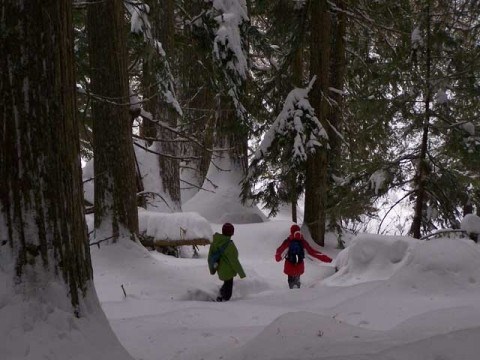Prince George is B.C.'s bull's-eye.
Not only does the timber capital anchor the centre of the province, it's also a point of convergence for winter adventure in the north. On offer is a smorgasbord of recreational options: outdoor speed skating on an Olympic-sized oval complete with its own Zamboni, cross-country skiing at the Otway Nordic Centre, downhill skiing and riding at Powder King Mountain Resort, and snowshoeing in old-growth forests. Small wonder that with so much on offer "PG" is slated to host the 2015 Canada Winter Games.
Last January, the Outdoor Life Adventure Co. guided Pique on a snowshoe trip through an ancient forest. In a region with forests devastated by mountain pine beetles, it was wonderful to discover pockets of ancient cedars that rival those on Cougar Mountain in Whistler or the slopes surrounding Chilliwack Lake in the Fraser Valley. Neither of the latter offers quick access from a major thoroughfare, as does the grove east of Prince George adjacent to the Yellowhead Highway. "We're just discovering the significance of this area," David Connell said while tramping beneath cedar boughs heavily laden with fresh powder snow.
Since 2007, the professor in the University of Northern British Columbia's school of environmental planning has studied the community and economic benefits of non-timber use of this former cut block in the inland rain forest. "There's a sense of 'being' here that you won't find elsewhere-the sense of appreciation for who we are as human beings," he observed. "Tourists tell us that one of the highlights of a trip here is the sense of discovering a place that's not very well known or publicized. This is one of a dozen such unique sites in the world."
Numbers tell the tale. Since its official opening in 2006, the Ancient Forest Trail has grown hugely in popularity, from an initial visitor count of hundreds to almost 10,000 in 2009. As Outdoor Life Adventure Co. owner-operator Laurella Gabert sees it, there's a good reason for that: "There aren't that many places for tourists to stop along Highway 16 [Yellowhead Highway] in the Robson Valley, so a lot of them pull in here to break up their journey."
Unlike many recent arrivals who offer similar reasons for having settled locally-blaming the SDG, or Some Damn Guy/Girl, syndrome-Gabert lays claim to deep roots. "In the early 1900s, my great-grandparents got off the train in the middle of nowhere, cleared bush, and started a mill." Today, Via Rail service between Jasper and Prince George still drops visitors at her family's doorstep in what are now the twin hamlets of Loos and Crescent Spur. "The railway runs right through the middle," she told Pique . "It [Crescent Spur] is a strange little community of perhaps 37 people. My husband, Trevor, and I moved here with our kids seven years ago after the forest industry shut down."
With Prince George and McBride just an hour or so away, Gabert insisted that she enjoys the best of both worlds. "Trevor and I have been in the outdoors forever. When we arrived in Crescent Spur, one of our neighbours was a long-time member of the Caledonia Ramblers, a Prince George hiking club. Talking with him led us to explore the rough footpath that the club had cleared through the so-called ancient forest, which at that time was designated a cut block and slated for logging."
Thanks in large part to lobbying efforts by club members and local biologists like Connell-abetted by a provincial government reassessment of the tourism benefits of maintaining a visually pleasing landscape along Highway 16-the Ancient Forest Trail, then in McBride-based TRC Cedar's timber licence, and an accompanying route on nearby Driscoll Ridge were set aside as a recreation trail and interpretive site. "Lots of old-growth cedar in the Robson Valley is still designated as cut blocks," Gabert related. "We lucked out that all this change was happening while we were starting our business."
The Robson Valley spreads roughly east-west between Prince George and Valemont, and is home to endangered herds of mountain caribou. The valley's prime characteristic, along with the Fraser River, is its lush interior cedar-hemlock forest. Much of the valley is classified as rain-forest wetland, which accounts for the numerous stands of western red cedar. Whether you're making tracks on foot or by snowshoe, no matter how many times you stand beside one of these behemoths, the scale of so much biomass on display brings you up short.
In winter, the silence that imbues the stand, aside from the occasional branches creaking in the cold, is a rare refreshment indeed. Time and again, Connell and Gabert stopped to examine distinguishing features, such as cedar trunks patterned with gold-dust lichen, which they said indicated the trees were at least 250 years old, the benchmark for ancient-forest designation. In the years since the Caledonia Ramblers first brushed out the trail, a multitude of improvements have been added, including wooden bridges, staircases, and boardwalks, plus interpretive signs that make a snowshoe trek there not only a pleasant physical workout but a highly rewarding introduction to the intricacies of the forest environment.
"The valley is more than a location or destination," Gabert said. "It's a place steeped in history, rich in wildlife, rivers, mountains, and lakes that B.C. is so famous for. We've been exploring for years and have yet to find an equal match to its unique beauty in any of our other travels."
Access: For details on snowshoe tours in the ancient forest, visit the Outdoor Life Adventure's website, www.outdoorlifeadventures.com. Find tourism information on Prince George and northern B.C. at the Hello BC website , www.hellobc.com
Writer-broadcaster Jack Christie is the author of The Whistler Book (Greystone Books). To learn more, visit www.jackchristie.com




